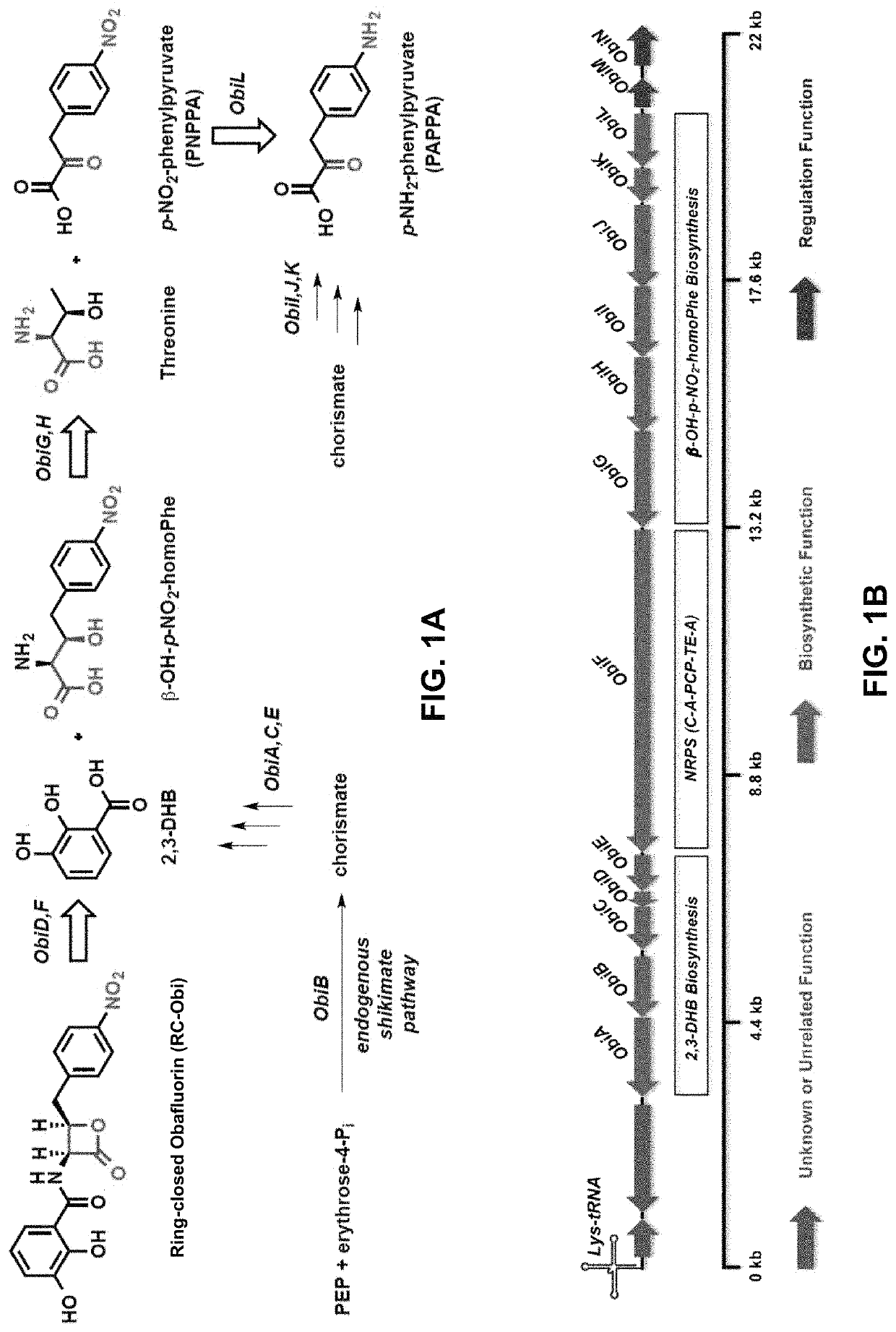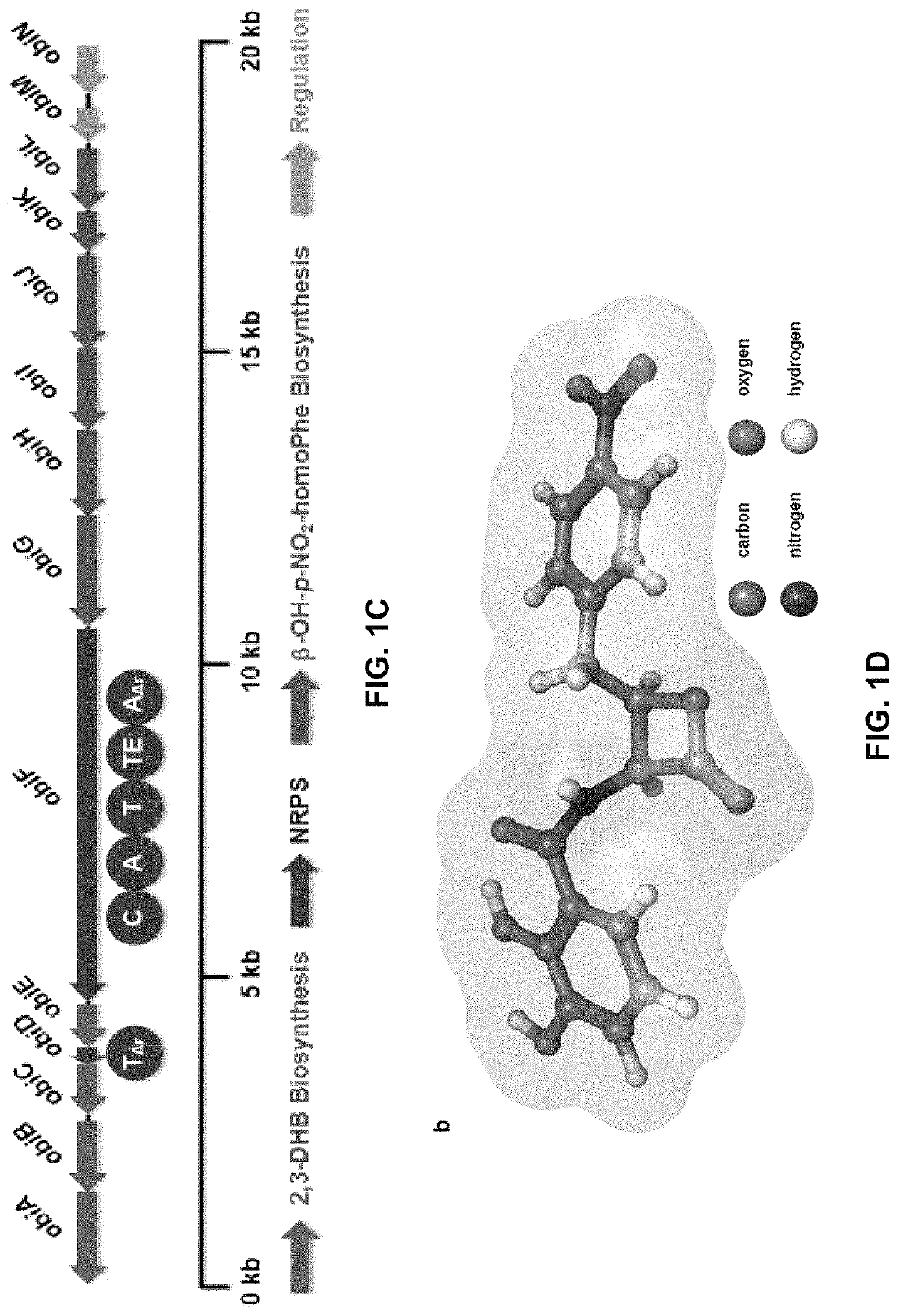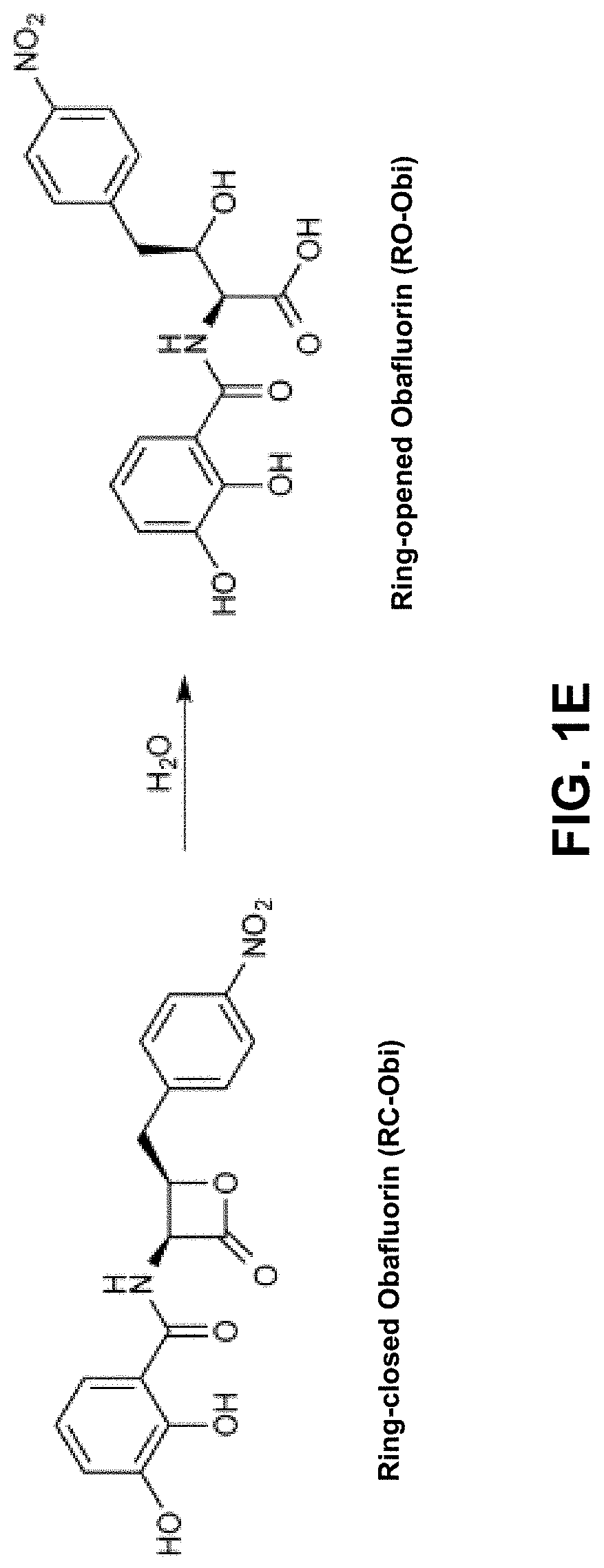Chemoenzymatic synthesis of peptide beta-lactones and beta-hydroxy acids
a technology of peptide betalactones and betahydroxy acids, which is applied in the direction of enzyme production/based bioreactors, lyases, transferases, etc., can solve the problem of reducing the likelihood of identifying a biosynthetic enzyme catalysis of -lactone ring formation
- Summary
- Abstract
- Description
- Claims
- Application Information
AI Technical Summary
Benefits of technology
Problems solved by technology
Method used
Image
Examples
example 2
f ObiG, ObiH, ObiI, ObiD, ObiF ObiF-C1141S, ObiF-C1141A, CS-ObiD and CS-ObiF
[0274]To demonstrate the cloning of various enzymes associated with the biosynthesis of RC-Obi, the following experiments were conducted.
[0275]Gene sequences were amplified from either P. fluorescens ATCC 39502 gDNA or C. shinanonensis DSM 23277 gDNA (isolated using Qiagen DNeasy Blood & tissue kit following provided instructions) using forward and reverse primers designed for each gene (see Tables 6 and 7 below) and a Herculase II Fusion DNA Polymerase kit.
[0276]
TABLE 6PCR PrimersSEQIDNucleotide SequencePrimerNO:(5′ to 3′)*ObiD_F 8GAACTGGGGAAGGCCATATGACCCAGObiD_RC 9TCGAAAAGCTTCATGGCTGCTCGCACTCObiF_F10GTTAAACTCATATGTCAGCCTCATTCACObiF_RC11CCAGTTAAGCTTTGGGTTTATTGGObiF_C1141S_F12GTCTACGGGCACAGCGCCGGTAACObiF_C1141A_F13GTCTACGGGCACGCAGCCGGTAACObiF_Mut_RC14GATAATCGGCCCGCTCAACGObiG_F15GGTGTATCAGCTAGCCCAACGATGObiG_RC16GGTAAATGAAAGCTTGGTCATGCCTTGObiH_F17GCAGAGAAACCATATGAGCAATGTCObiH_RC18GGGAAGCTTGACCATCGTTGObiL_F19CA...
example 3
n and Purification of ObiG, ObiH, ObiL, ObiD, ObiF, ObiF-C1141S, ObiF-C1141A, CS-ObiD and CS-ObiF
[0282]To demonstrate the expression and purification of various enzymes associated with the biosynthesis of RC-Obi, the following experiments were conducted.
[0283]For protein expression, a 5 mL culture of E. coli BL21 harboring the appropriate plasmid (see Table 8 above) was grown overnight in LB containing 50 μg / mL kanamycin with agitation at 37° C. A 200 μL aliquot of this culture was used to inoculate 500 mL of terrific broth (12 g / L tryptone, 24 g / L yeast extract, 5 g / L glycerol, 17 mM KH2PO4, 72 mM K2HPO4) containing 50 μg / mL kanamycin. The culture was grown at 37° C. with agitation until OD600 reached approximately 0.4. The culture was cooled in an ice bath for 20 min, then 500 μL of a sterile 0.5 M IPTG solution was added. The culture was then incubated with agitation for 18 hrs. (at 15° C. for ObiG / ObiF / CS-ObiF, and at 20° C. for ObiD / CS-ObiD / ObiH / ObiL).
[0284]All subsequent prote...
example 4
is of WT-ObiF to ObiF-CH1141S and ObiF-C1141A
[0290]To produce mutated analogs of wild-type ObiF, the following experiments were conducted.
[0291]Mutagenesis primers (see Table 6 and Table 7 above) were phosphorylated using T4 Polynucleotide Kinase according to product instructions. Primers were taken directly from phosphorylation mixture for use in PCR amplification. PCR was carried out using a Herculase II Fusion DNA Polymerase kit. After amplification, 1 μL FastDigest DpnI was added to PCR reaction mixture to digest template plasmid with wild type gene. Reaction was incubated at 37° C. for 60 min, then plasmids were purified using gel electrophoresis methods similar to those described in Example 3 above. Purified plasmids were ligated overnight at 16° C. using T4 DNA ligase, then transformed into electrocompetent E. coli TOP10 cells. Plasmids were sequenced using methods similar to those described in Example 1 to confirm the desired mutations.
[0292]The experiments described above r...
PUM
 Login to View More
Login to View More Abstract
Description
Claims
Application Information
 Login to View More
Login to View More - R&D
- Intellectual Property
- Life Sciences
- Materials
- Tech Scout
- Unparalleled Data Quality
- Higher Quality Content
- 60% Fewer Hallucinations
Browse by: Latest US Patents, China's latest patents, Technical Efficacy Thesaurus, Application Domain, Technology Topic, Popular Technical Reports.
© 2025 PatSnap. All rights reserved.Legal|Privacy policy|Modern Slavery Act Transparency Statement|Sitemap|About US| Contact US: help@patsnap.com



